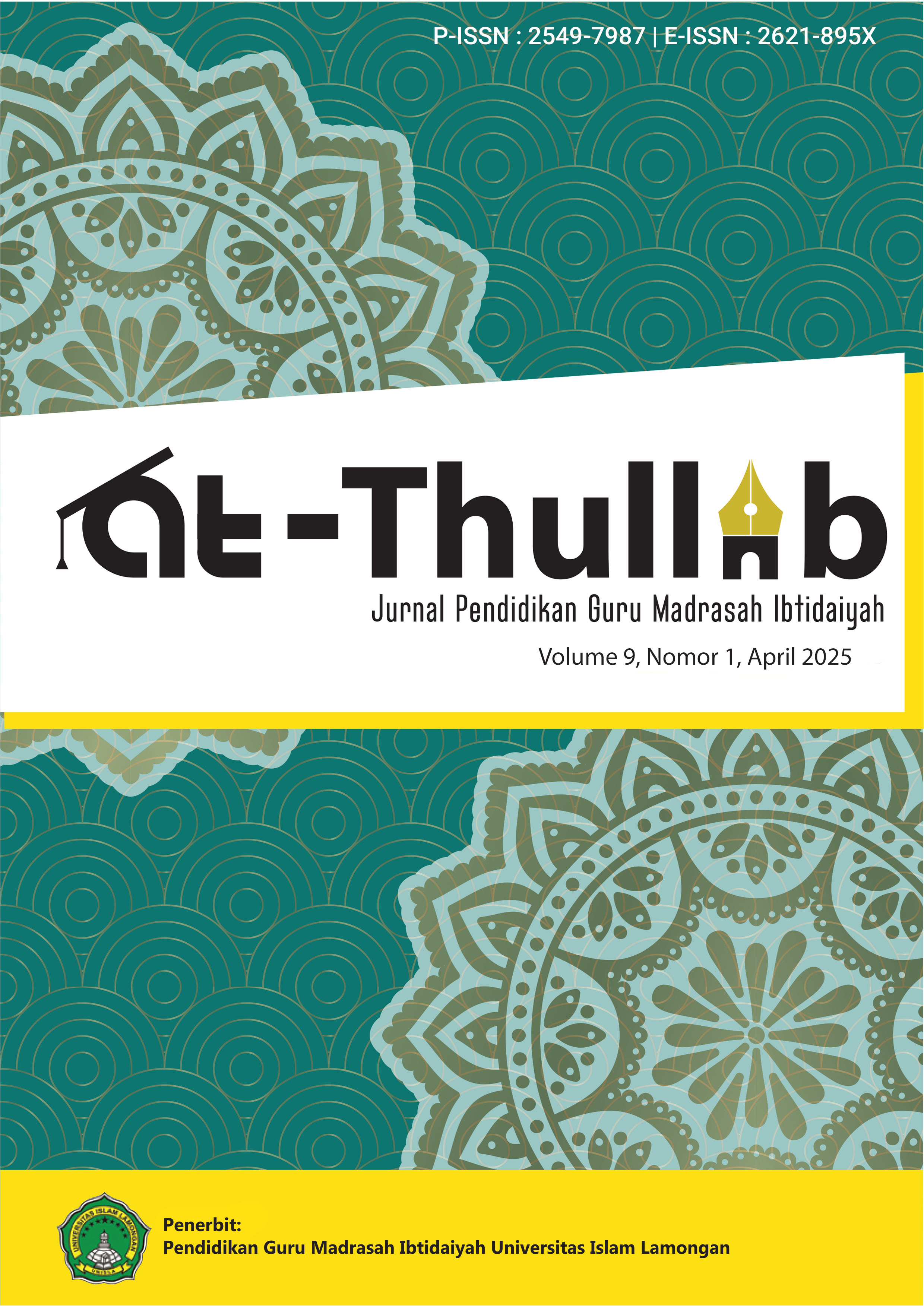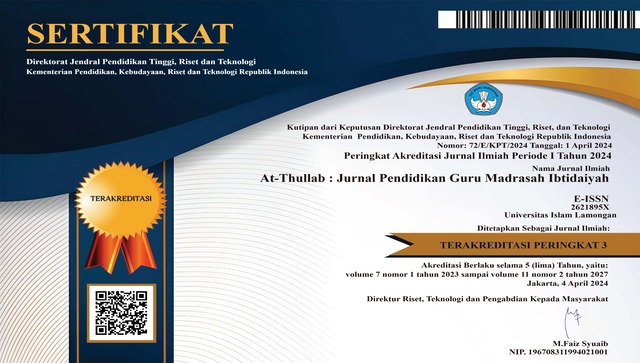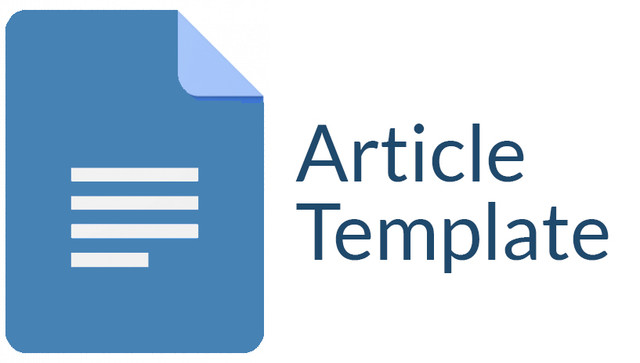The Influence of Fraction Puzzle Media on the Mathematical Concept Understanding Ability of Elementary School Students
DOI:
https://doi.org/10.30736/atl.v9i1.2342Keywords:
Media, Puzzle, Ability to Understand Mathematical Concepts, FractionAbstract
This research aims to determine the effect of fraction puzzle media on students' ability to understand mathematical concepts. This research was conducted at SDN Petir 04 in class III, the second semester of the 2023/2024 academic year. The research method used is quasi-experimental with a nonequivalent control group design. The research samples in this study were class III-B students as the experimental class and class III-C students as the control class, which were obtained using cluster random sampling techniques. The test given is an essay with seven questions. The statistical analysis using the Independent Sample T-test showed a significance value of 0.000 < 0.05, leading to the rejection of H0 and acceptance of H1. This confirms that students in the experimental class, who were taught using fraction puzzle media, demonstrated better conceptual understanding than those in the control class, who received conventional instruction. The fraction puzzle media enhances learning by providing a hands-on, interactive experience that helps students visualize and manipulate fraction concepts more effectively. This approach facilitates deeper comprehension, reduces misconceptions, and improves problem-solving skills related to fractions. Therefore, integrating fraction puzzle media into mathematics instruction can effectively enhance students’ conceptual understanding and engagement in learning fractions.
Downloads
References
Arikunto, S. (2010). Research methods. Jakarta: Rineka Cipta, 173.
Brophy, D. R. (1998). Understanding, measuring, and enhancing individual creative problem-solving efforts. Creativity Research Journal, 11(2), 123–150. https://doi.org/10.1207/s15326934crj1102_4
Diputra, K. S., Suryadi, D., Herman, T., & Jupri, A. (2023). Analysis of the Elementary School Students’ Learning Obstacles: A Case Study on the Concept of Fractions. Al Ibtida: Jurnal Pendidikan Guru MI, 10(1), 13. https://doi.org/10.24235/al.ibtida.snj.v10i1.13078
Endramawati, T. A. (2021). Efforts to Improve Students' Ability to Understand Concepts and Confidence Through the Guided Discovery Learning Model. Didaktika: Journal of Educational Thought, 27(2).
Fauzi, I., & Suryadi, D. (2020). Learning Obstacle the Addition and Subtraction of Fraction in Grade 5 Elementary Schools. In Jurnal Kajian Pendidikan Islam (Vol. 12, Issue 1).
Firma, I., & Dian, N. (2021). Mathematics Realistic Education (RME) Model on Fractional Materials in Elementary Schools. Journal of Basicedu, 5(4), 1888–1899.
Hardani. (2020). Metode Penelitian Kualitatif & Kuantitatif. Pustaka Ilmu Group.
Johar, R., Khairunnisak, C., & Rohaizati, U. (2022). Students’ Mathematical Representation Ability in Learning Algebraic Expression using Realistic Mathematics Education. Jurnal Didaktik Matematika, 4185, 151–169. https://doi.org/10.24815/jdm.v9i1.25434
Kholid, M. N., Imawati, A., Swastika, A., Maharani, S., & Pradana, L. N. (2021). How are Students’ Conceptual Understanding for Solving Mathematical Problem? Journal of Physics: Conference Series, 1776(1). https://doi.org/10.1088/1742-6596/1776/1/012018
Kilpatrick, J., Swafford, J., & Findell, B. (2001). Adding it up: Helping children learn mathematics.
Lince, R. (2016). Creative Thinking Ability to Increase Student Mathematical of Junior High School by Applying Models Numbered Heads Together. Journal of Education and Practice, 7(6), 206–212. www.iiste.org
Mason, J. Burton, L. & Stacey, K. (2011). Thinking Mathematically (Second Extended Edition). Prentice Hall (Pearson).
Muleong, L. (2012). Qualitative Research Methods. Remaja Rosdakarya.
NCTM. (2009). Focus in high school mathematics: Reasoning and sense making. National Council of Teacher Mahtematics.
Niagara, A., Widyatiningtyas, R., & Rahmawati, D. (2022). The Use of Fractional Block Props to Improve the Ability to Understand the Concept of Fractions in Grade III Elementary School Students. (2), 2621–2637.
Nurani, M., Riyadi, R., & Subanti, S. (2021). The Profile of Understanding Mathematical Concepts is Reviewed from Self Efficacy. Axioms: Journal of Mathematics Education Study Program, 10(1), 284. https://doi.org/10.24127/ajpm.v10i1.3388
OECD. (2009). The PISA 2009 Assessment Framework: Key Competencies in Reading, Mathematics, and Science. 2009.
Orton, A. (2004). Learning Mathematics: Issues, Theory and Classroom Practice. Continuum.
Permendikbud. (2016). Attachment to the Regulation of the Minister of Education and Culture of the Republic of Indonesia Number 20 of 2016 concerning Competency Standards for Graduates of Primary and Secondary Education.
Salim Nahdi, D., & Gilar Jatisunda, M. (2020). Conceptual Understanding and Procedural Knowledge: A Case Study on Learning Mathematics of Fractional Material in Elementary School. Journal of Physics: Conference Series, 1477(4). https://doi.org/10.1088/1742-6596/1477/4/042037
Setianingrum, A., Iriawan, S. B., & Mufliva, R. (2023). Diactic Design in Mathematics Learning of Grade IV Fractional Materials in Elementary Schools. 63 JPGSD (Issue 1).
Sugiyono. (2014). Educational Research Methods Quantitative, Qualitative, and R&D Approaches. Alphabeta.
Sugiyono. (2015). Educational Research Methods Quantitative, Qualitative, and R&D Approaches. Alphabeta.
Sugiyono. (2016). Quantitative, Qualitative and R&D Research Methods. PT Alphabet.
Suryaningsih, T. (2023). The Effect of The Use of Realia Media on Students' Ability to Understand Concepts and Learning Interests in Grade III Flat Building Materials at Sdn Bojong Sempu 01. Syarif Hidayatullah State Islamic University, Jakarta.
Suryaningsih, T., & Astuti, M. A. (2021). The Effect of the Open Ended Learning Model on the Mathematical Creative Thinking Ability of Grade IV Students on Fractional Materials. Elementar (Elementary of Tarbiyah): Journal of Elementary Education, 1(1), 95–104.
Suryaningsih, T., Marini, A., & Zakiah, L. (2024). Mathematics Problem Solving Through Make a Drawing Strategy for Elementary School Students with Mild Intellectual Disability. Auladuna: Jurnal Pendidikan Dasar Islam, 11(1), 31–41.
UNESCO. (2006). School and Teaching Practices for the Twenty-first Century Challenges: Lessons from the Asia-pacific Region (Regional Synthesis Report, Ed.). UNESCO.
Valentza, D. (2024). Proceedings of the Basic Scientific Conference on the Utilization of Math Puzzle Games Applications in Mathematics Learning. Proceedings of the Basic Scientific Conference, 1694–1700.
http://prosiding.unipma.ac.id/index.php/Kid
Zhan, Z., He, W., Yi, X., & Ma, S. (2022). Effect of Unplugged Programming Teaching Aids on Children’s Computational Thinking and Classroom Interaction: with Respect to Piaget’s Four Stages Theory. 60(55), 1277–1300. https://doi.org/10.1177/07356331211057143
Downloads
Published
How to Cite
Issue
Section
License
Copyright (c) 2025 Ahda Syarifah , Tri Suryaningsih, Rohmat Widiyanto

This work is licensed under a Creative Commons Attribution-ShareAlike 4.0 International License.
Authors who publish with this journal agree to the following terms:
The journal allow the authors to hold the copyright without restrictions and allow the authors to retain publishing rights without restrictions. Authors retain copyright and grant the journal right of first publication with the work simultaneously licensed under a Creative Commons Attribution-ShareAlike 4.0 International License. that allows others to share the work with an acknowledgement of the work's authorship and initial publication in this journal.
Authors are able to enter into separate, additional contractual arrangements for the non-exclusive distribution of the journal's published version of the work (e.g., post it to an institutional repository or publish it in a book), with an acknowledgement of its initial publication in this journal.
Authors are permitted and encouraged to post their work online (e.g., in institutional repositories or on their website) prior to and during the submission process, as it can lead to productive exchanges, as well as earlier and greater citation of published work (See The Effect of Open Access).
The journal allows third parties (readers, researchers, and others) to share and adapt the material in line with the license. In addition, the material must be given appropriate credit, provided with a link to the license, and indicate if changes were made. If authors remix, transform, or build upon the material, they must distribute their contributions under the same license as the original.













